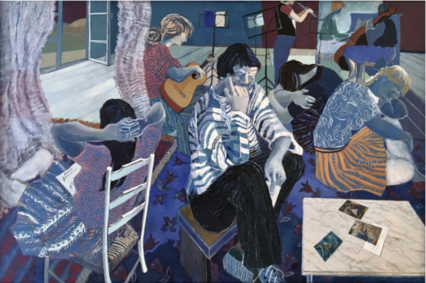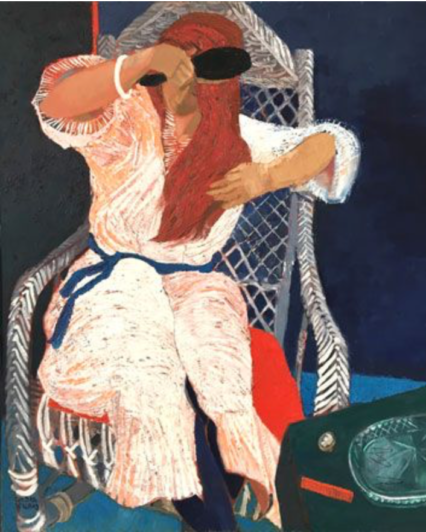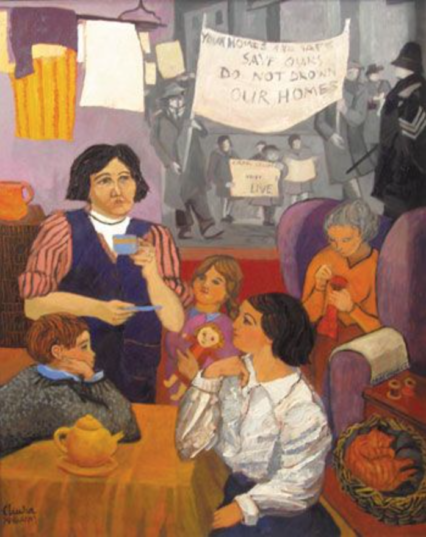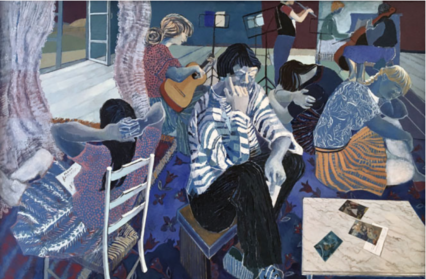Josie Cray reviews the Welsh artist Claudia Williams retrospective at the Martin Tinney Gallery in Cardiff. Her work often captures moments of everyday activities.

Friends run along the beach in swimming costumes with seaweed and footballs in their hands. Families play games on the floor of bedrooms. Women comb their hair and cats look on pensively. Claudia Williams RCA (1933-) has spent her career capturing intimate moments of the everyday. Her bold use of colour and patterns imbue her paintings with a timeless quality, one which repeatedly draws on the magic of every day to bring these moments to life. Williams began painting at an early age and enrolled at the Chelsea School of Art in 1953. She has won numerous prizes, awards, and scholarships, and is still producing work. Williams is a well-known figure on the Welsh art scene and has found international acclaim in France with her unique style and honest subject matter.
One of Williams’ largest paintings, ‘Listening to Music/Gwrando ar Gerddoriaeth’ (1984), is a stunning example of an artist in full control of a blue colour palette and mesh of patterns that draw the eye around the image as if following the music in the air. A group of friends sit in a room, some playing instruments, others listening intently. In the foreground sits a marble table with what appears to be photographed on suggesting both a timelessness to the scene and a nostalgia—a moment which can’t be relived. Blue seeps into the skin of listeners, contrasting with blonde hair. It mixes with peaches and purples in the clothing of the group of listeners. The use of blue seems to capture the tones of music in the air, the concentration of listeners and emphasises the suspended or timeless nature of this gathering. Curtains fluttering in an unseen breeze and stillness sets across the moment. And yet, William’s dazzling array of patterns—from the stripes in jumpers and polka dots of skirts, to the floral carpet and rough trainer sole—adds movement to this settled painting. Pops of colour, whites and yellows contrasting with the blue mood, allow the clashing yet harmonious patterns to lead your eye around the scene so beautifully captured. Here, Williams’ displays her focus on every day to its maximum scale: the enormity of the canvas displays the enormity of the moment, of the time we spend together in the present.

This concern with every day, with moments that are somewhat private and fleeting, is depicted by Williams with such honesty and skill. Among her other works the blue returns and suggests both nostalgia and timelessness to the moments, we spend together. In ‘Bedroom at Rochefort’ (1997) a cat sits on the bed staring pensively at us, the viewer, positioned so carefully as both seer and subject. At the end of the bed, a man stares contently at the person in bed drawing the still cat. Blue is the foundation of this image—even down to the scraped paint on the page which seems to suggest a ballpoint sketch of the cat. Similarly, ‘Story Time’ (2016), which depicts two children and a woman engaged in a story is steeped in blue. The use of pastel adds a chalkiness and unrefined perspective which suggests this moment as a memory, possibly fading. The bright orange book, large and contrasting to the blues, is the symbol that reminds us of this intimate family moment where stories are told, and adventures are imagined.
Williams’ focus on intimate, everyday moments is possibly best witnessed in ‘Brushing Hair’ (1995). A woman sits in a white wicker chair combing her auburn hair. In front of her on a green table sits a bright orange comb and green broach with a white silhouette profile. ‘Brushing Hair’ sees Williams make use of a contrasting colour palette as peaches sit alongside deep, rich blues. Thick brushstrokes capture the material of the woman’s dress, layering white and peach until it seems you could feel the cloth through the canvas. Similarly, Williams adds depth and dimension to the auburn hair by scraping and layering paint until we can see the tangles in the woman’s hair. Across her work, Williams reveals in interest in women’s grooming—moments which are both private and singular as well as moments of coming together, see in a number of her other paintings capture women at hairdressers, such as ‘Hair-do’ (2016) and ‘Hair Dressing and Patterned Wallpaper’ (2016).

Williams doesn’t shy away from controversial subjects in Welsh history, drawing this into her focus of every day and how these historical moments impact the minute everyday living of people in Wales. ‘Remembering the Demonstration/Cofio’r Gwrthdystio’ (2009) captures both the present and the past as a woman seemingly relays the story of the demonstrations around the drowning of Tryweryn, a controversial act in 1965. Here, Williams displays a range in her colour palette which creatively depicts the present and past alongside each other. Yellows and purples both contrast and harmonise in the front room where the woman retells her story. Children look up to her while she stares into the distance caught in her memory. Behind her, a combination of greys and creams depict the bodies marching and banners held high in protest. Looming over a figure darning a sock is a dark grey police officer on the boundary of past and present, seemingly keeping everything in order. The memory seeps into the present as the grey figures burst from the frame of the memory and blot out the purple walls. Williams appears to comment on the connection between past and present, on our ability to keep history alive through storytelling and through these small, everyday moments where we share with those around us our lives.
Claudia Williams (RCA) other work is available here.
Josie Cray is an avid contributor to Wales Arts Review.



 Enjoyed this article? Support our writers directly by buying them a coffee and clicking this link.
Enjoyed this article? Support our writers directly by buying them a coffee and clicking this link.








